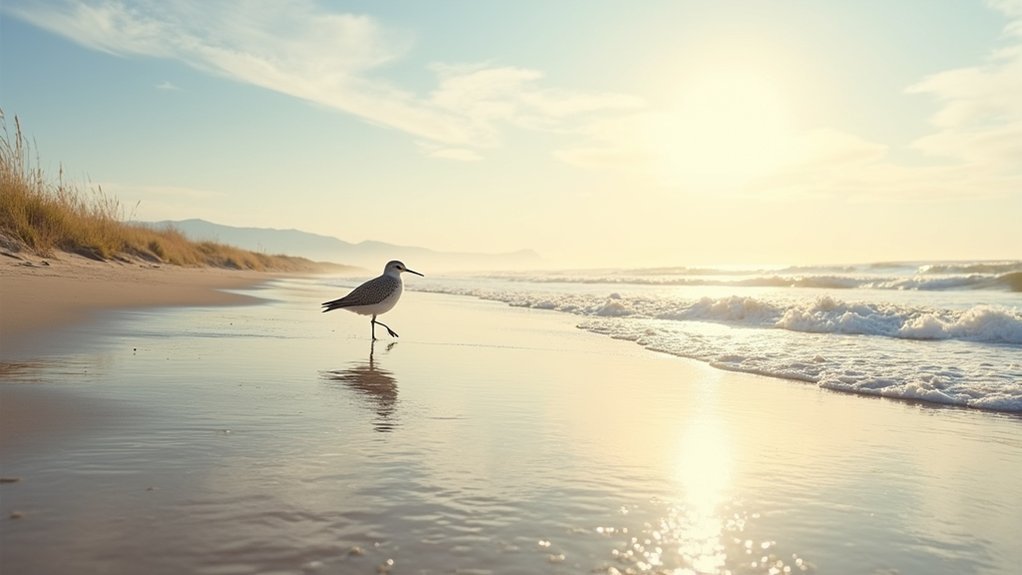To photograph elusive shorebirds in urban settings, master stealth by staying low and using natural cover. Time your outings during early morning or evening hours when birds are most active. Carry essential gear including a telephoto lens (300mm+) and a stable tripod. Anticipate behaviors like feeding patterns to capture authentic moments. Always maintain distance and avoid flash photography to respect these sensitive creatures. The following strategies will transform your urban wildlife portfolio from ordinary to extraordinary.
Master Stealth Approaches for Urban Shorelines

While urban shorelines offer convenient access to shorebird photography, they require specialized stealth techniques to capture intimate images.
Get low to the ground when approaching birds—this reduces your profile and minimizes perceived threats, allowing for more natural photographs.
The art of becoming invisible to shorebirds begins with humility—get low and you’ll capture their true essence.
Utilize natural cover like rocks or vegetation to conceal yourself while photographing these sensitive creatures.
Understanding behavior patterns, such as the Piping Plovers’ characteristic “run, run, stop” movement, helps you anticipate their actions and position yourself accordingly.
Remain patient and still; shorebirds often become accustomed to your presence over time and may venture closer for stunning close-ups.
Plan your sessions during prime lighting conditions—early morning or late afternoon—when birds are most active and the golden light enhances your images.
Perfect Timing: Finding Hidden Avian Visitors
When should you venture out to capture those elusive shorebirds? Perfect timing is everything. Head out during early morning or late afternoon when the light is most favorable and shorebird activity increases dramatically. These golden hours reveal hidden avian visitors that remain inactive midday.
Understanding tidal patterns will maximize your success—low tide exposes mudflats and sandbars where shorebirds actively forage. Check eBird for recent sightings and known hotspots before planning your outing.
For the best variety, schedule your photography during spring and fall migration periods when rare and transient species pass through urban coastlines.
Once on location, remain patient and quiet while scanning the shoreline for camouflaged birds like Piping Plovers, which blend remarkably with their sandy surroundings. Their subtle movements often give away their presence.
Essential Gear for City Waterfront Photography

Successful shorebird photography in urban settings demands specialized equipment to capture these cautious subjects. A telephoto lens of at least 300mm is your most valuable tool, allowing you to maintain distance while getting detailed shots of wary birds.
Don’t overlook the importance of waterproof camera gear when shooting near splashing waves and humid environments. A sturdy tripod or monopod will stabilize your shots in windy waterfront conditions, particularly vital when using heavy telephoto lenses.
Always carry extra batteries and memory cards—shorebirds often appear unexpectedly, and you’ll want to be prepared for extended sessions.
Complete your kit with a lightweight camera bag featuring sandproofing to protect your equipment while maneuvering between urban shooting locations. These photography tips guarantee you’re ready to document shorebirds without compromising your gear’s safety.
Capturing Behavior: Telling the Story of Rare Sightings
With appropriate gear secured, your focus shifts to the storytelling aspect of shorebird photography. Great photos emerge when you anticipate flight patterns of Common Terns and Black Skimmers during feeding or courtship displays.
To capture compelling images of Piping Plovers, observe their distinctive “run, run, stop” movement, which reveals their unique personality.
Engage with local birding communities and resources like eBird to locate elusive shorebirds efficiently. Once found, patience becomes your greatest asset—get low for an intimate perspective that transforms ordinary images into powerful narratives.
During nesting season, adjust your camera settings to freeze critical moments like hatching, which showcase the triumph of these species in urban environments.
Storytelling through photography isn’t just about documenting birds—it’s about conveying their relationship with city shores.
Ethical Documentation Techniques for Urban Conservation

Ethical photography forms the cornerstone of shorebird conservation in urban environments. As you document these elusive birds along city shores, your responsible practices directly impact their wellbeing and habitat preservation.
Thoughtful wildlife photography helps raise awareness while protecting vulnerable species.
- Maintain a respectful distance – Use telephoto lenses instead of approaching birds, avoiding flash photography that disrupts natural behaviors, especially during nesting season.
- Share with purpose – Upload observations to eBird to help track urban shorebird populations, and use social media to educate others about conservation challenges.
- Connect with community – Participate in beach clean-ups before photography sessions, engage fellow beachgoers about shorebird protection, and advocate for urban conservation through your compelling images.
Frequently Asked Questions
How Do You Photograph Shore Birds?
Get low to the bird’s eye level, use a 300mm+ telephoto lens, wait patiently, shoot in early morning or late afternoon light, and utilize continuous shooting mode to capture their quick movements.
How to Photograph Birds Without Scaring Them?
You’ll avoid scaring birds by moving slowly, using a low stance, and staying patient. Wait for them to approach instead of chasing. A telephoto lens helps capture details while maintaining respectful distance.
What Is the Best Time to Photograph Birds?
Photograph birds during early morning or late afternoon when light is soft. You’ll get better colors and details. Overcast days are also great for even lighting. Consider seasonal migrations for more diversity.
How to Improve Your Bird Photography?
You’ll improve your bird photography by getting down to eye level, using a telephoto lens, shooting in continuous mode, photographing during sunrise/sunset, and practicing patience. These techniques capture more intimate, detailed images.
In Summary
With these techniques, you’ll transform from frustrated observer to skilled urban shorebird photographer. Don’t let city settings limit your wildlife photography—they’re unique opportunities to document species adapting to human environments. Your images won’t just be beautiful keepsakes; they’ll contribute valuable data about urban wildlife. Remember, patience and respect for these resilient creatures will reward you with remarkable images few others capture.





Leave a Reply